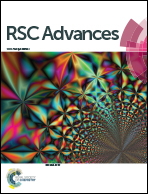Attapulgite-doped electrospun poly(lactic-co-glycolic acid) nanofibers enable enhanced osteogenic differentiation of human mesenchymal stem cells†
Abstract
The extracellular matrix mimicking property of electrospun polymer nanofibers affords their uses as an ideal scaffold material for differentiation of human mesenchymal stem cells (hMSCs), which is important for various tissue engineering applications. Here, we report the fabrication of electrospun poly(lactic-co-glycolic acid) (PLGA) nanofibers incorporated with attapulgite (ATT) nanorods, a clay material for osteogenic differentiation of hMSCs. We show that the incorporation of ATT nanorods does not significantly change the uniform morphology and the hemocompatibility of the PLGA nanofibers; instead the surface hydrophilicity and cytocompatibility of the hybrid nanofibers are slightly improved after doping with ATT. Alkaline phosphatase activity, osteocalcin secretion, calcium content, and von Kossa staining assays reveal that hMSCs are able to be differentiated to form osteoblast-like cells onto both PLGA and PLGA–ATT composite nanofibers in osteogenic medium. Most strikingly, the doped ATT within the PLGA nanofibers is able to induce the osteoblastic differentiation of hMSCs in growth medium without the inducing factor of dexamethasone. The fabricated organic/inorganic hybrid ATT-doped PLGA nanofibers may find many applications in the field of tissue engineering and regenerative medicine.


 Please wait while we load your content...
Please wait while we load your content...